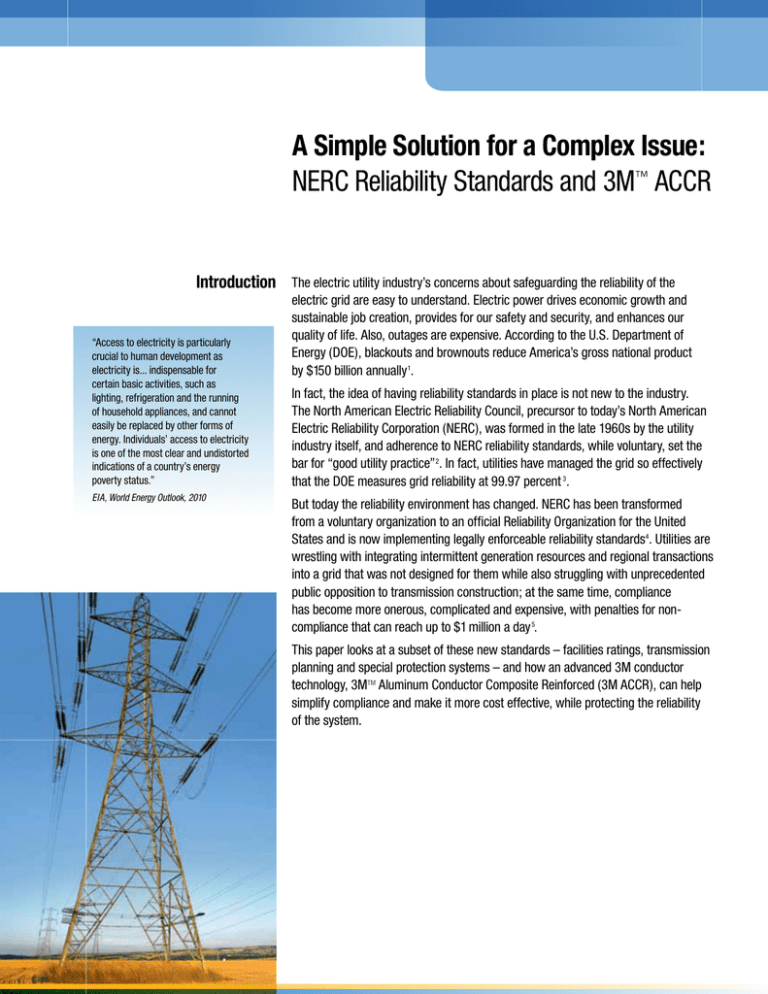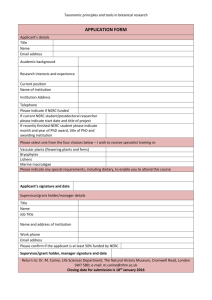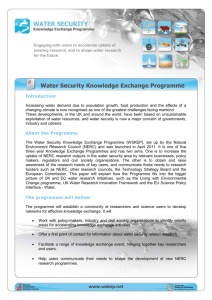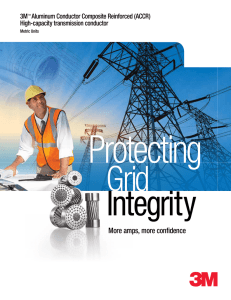
A Simple Solution for a Complex Issue:
NERC Reliability Standards and 3M™ ACCR
Introduction
“Access to electricity is particularly
crucial to human development as
electricity is... indispensable for
certain basic activities, such as
lighting, refrigeration and the running
of household appliances, and cannot
easily be replaced by other forms of
energy. Individuals’ access to electricity
is one of the most clear and undistorted
indications of a country’s energy
poverty status.”
EIA, World Energy Outlook, 2010
The electric utility industry’s concerns about safeguarding the reliability of the
electric grid are easy to understand. Electric power drives economic growth and
sustainable job creation, provides for our safety and security, and enhances our
quality of life. Also, outages are expensive. According to the U.S. Department of
Energy (DOE), blackouts and brownouts reduce America’s gross national product
by $150 billion annually 1.
In fact, the idea of having reliability standards in place is not new to the industry.
The North American Electric Reliability Council, precursor to today’s North American
Electric Reliability Corporation (NERC), was formed in the late 1960s by the utility
industry itself, and adherence to NERC reliability standards, while voluntary, set the
bar for “good utility practice”2. In fact, utilities have managed the grid so effectively
that the DOE measures grid reliability at 99.97 percent 3.
But today the reliability environment has changed. NERC has been transformed
from a voluntary organization to an official Reliability Organization for the United
States and is now implementing legally enforceable reliability standards4. Utilities are
wrestling with integrating intermittent generation resources and regional transactions
into a grid that was not designed for them while also struggling with unprecedented
public opposition to transmission construction; at the same time, compliance
has become more onerous, complicated and expensive, with penalties for noncompliance that can reach up to $1 million a day 5.
This paper looks at a subset of these new standards – facilities ratings, transmission
planning and special protection systems – and how an advanced 3M conductor
technology, 3MTM Aluminum Conductor Composite Reinforced (3M ACCR), can help
simplify compliance and make it more cost effective, while protecting the reliability
of the system.
A Simple Solution for a Complex Issue: NERC Reliability Standards and 3M™ ACCR
Facilities Ratings –
Standards FAC-008
and FAC-009 6
“... an entity will receive highly favorable
treatment in compliance space for its
proactive approach to reliability and
support of this recommendation.”
North American Electric Reliability Corporation,
“Q&A - Consideration of Actual Field
Conditions in Determination of Facility
Ratings”, January 14, 2011, page 4.
Standard FAC-008 requires transmission and generation owners to have a
methodology in place and documented for assigning ratings to transmission facilities,
including transmission lines. Standard FAC-009 requires transmission and generation
owners to rate their transmission facilities using this methodology. While these
standards may seem straightforward, compliance was complicated in 2010 when
NERC issued its Facility Ratings Alert, recommending that transmission and generation
owners “… review their current facility ratings methodology to verify the methodology
used is based on actual field conditions”7. Assessments must consider ambient
conditions, operating limitations, conductor-to-conductor clearances and conductor
distance to objects occupying the right of way, including the ground itself 8.
Owners have 3 years to comply, and, at the end of each year, must provide a report
summarizing the assessments and identifying all transmission facilities where as-built
conditions are different from design conditions, resulting in incorrect ratings 9.
The issuance of this “recommendation” caused a flurry of activity, including webinars,
compliance application notices (CANs) and supporting documents, as the industry
sought clarification as to what was expected. And, while this NERC Alert is nominally
a recommendation, NERC has made it clear that non-compliance has implications.
Therefore, participating in the assessments demonstrates a “culture of reliability”
that is explicitly taken into account if a violation should occur and penalties are
considered10.
In addition, remediation is expected within one year from issue identification, or
on a schedule approved by the regional entity11. In the meantime, any line with a
discrepancy must be de-rated until the issue is fixed, affecting the amount of power
that can be carried on the line during normal operation and contingencies12. This has a
direct impact on a transmission owner’s ability to comply with transmission planning
standards as well.
Transmission Planning
Standards – Standards
TPL-001, 002,
003 and 00413
Systems must “…minimize the likelihood
and magnitude of interruption of firm
transfers or Firm Demand following
Contingency events”.
North American Electric Reliability Corporation,
“Reliability Standard TPL-001-1”, page 5,
note b, Feburary 17, 2011.
2
Transmission planning standards specify
that the Planning Authority and Transmission
Planner must demonstrate that its portion of
the system is planned such that the network
can be operated under defined conditions.
The conditions include normal operation
(Category A), N-1 contingency (Category B),
N-2 contingency (Category C) and extreme
contingency (Category D). The system
requirements vary depending on the defined condition being evaluated, but they
must “… minimize the likelihood and magnitude of interruption of firm transfers or
Firm Demand following Contingency events”14. In addition, the Planning Authority and
Transmission Planner must provide a written summary of its plans to achieve the
required system performance, including a schedule for implementation15.
Special Protection
Systems – Standards
003, 012, 013, 014,
015, 016 and 017 (plus
separate standards
for WECC)16
One way to meet the contingency planning standards is through implementing a
special protection system (SPS), also known as a remedial action scheme (RAS).
These systems are designed to detect abnormal or predetermined system conditions
and take corrective actions, including managing demand and generation or system
configurations to maintain stability, voltage levels or power flows17. They address
problems that include over- or under-frequency, voltage collapse, generator
instability, transfer limits, system separation, and equipment or transmission line
thermal overload18.
Putting together a compliant SPS is a complex task that includes defining logic
protocols, minimum and maximum remedial actions and maximum allowable response
time19. Utilities may need to invest in condition-sensing, arming, logic processing,
communications and action equipment 20. Ongoing maintenance and operations
must be established and followed. NERC standards also require redundancy – a
single SPS component failure cannot prevent the system from meeting performance
requirements21. Risks include the system not tripping when it is needed or tripping
when not needed22.
NERC has seven individual standards in place governing special protection systems,
as well as additional standards for the Western Electricity Coordinating Council (WECC).
They apply to transmission owners and operators, generation owners and reliability
organizations who are required to have procedures in place for tracking these systems,
testing and maintaining them, tracking system triggers and misoperations, correcting
problems and communicating with other protection and control systems, all of which
require significant data and documentation (see Standards referenced above).
In all this complexity,
a little simplicity
For clearance issues or thermallylimited transmission lines, there is a
simple solution available–reconductor
with advanced 3M™ ACCR.
While no one can argue with the importance of protecting transmission system
reliability, it is also clear that meeting today’s level of required compliance is
complicated, with potentially expensive consequences. One tool cannot address
all that is required.
However, when facility rating mitigation, contingency condition requirements or special
protection systems are driven by clearance issues or thermally-limited transmission
lines, there is a simple solution available – upgrade existing lines by reconductoring
with advanced transmission technology, such as 3M™ Aluminum Conductor Composite
Reinforced (ACCR).
ACCR is a high-temperature, low-sag conductor specifically designed as a drop-in
replacement for standard ACSR or ACSS conductors on existing lines – while delivering
as much as twice the capacity.
3M ACCR is the result of extensive technical development and years of testing in
laboratories and in the field by both 3M, located in St. Paul, Minnesota, and the DOE
through a joint program and in collaboration with several North American electric
utilities 23. Through years of testing and commercial use, its behavior under a wide
range of ambient and operating conditions is well-understood, documented and
modeled, providing solid substantiation for compliance documentation.
For copies of all 3M™ ACCR lab and field test
results, visit www.3m.com/ACCR
3
A Simple Solution for a Complex Issue: NERC Reliability Standards and 3M™ ACCR
3M™ Aluminum Conductor
Composite Reinforced (ACCR)
3M™ ACCR offers an upgrade of up to twice the capacity, using existing corridors and
towers while maintaining tensions and clearances. Its unique properties can also be
used to improve tensions and clearances with smaller upgrades or at existing capacity
ratings. For example, utilities in Maine and Tennessee are upgrading transmission lines
with ACCR to meet updated Army Corps of Engineers clearance requirements across
waterways.
Because existing towers are used, line upgrades with ACCR can typically be done at
a much lower cost than rebuilds. The upgrade would not change transmission line
footprints, structure height or line appearance, so it can help minimize the impact on
property owners, the environment and surrounding facilities. As a result, it can simplify
or, in some cases, eliminate lengthy, complicated and expensive permitting processes.
The installation process of replacing existing conductor with 3M ACCR is simple and
quick, allowing a quick return to required levels for de-rated lines.
Reconductoring with 3M™ ACCR can eliminate
thermal constraints impacting contingency
operations and the need for special protection
systems. It can also correct clearance issues
when nearby structures, topography or other
factors have changed over time.
Table 1
Core Property Comparison: ACCR vs. ACSR/ACSS
Conductor
Core Material
3M™ ACCR
Aluminum Matrix
ACSR/ACSS
Steel
Strength (ksi)
200
185
Density (lbs/in3)
0.122
0.282
Strength/Density
1,681
656
3.5
6.7
Coefficient of Thermal
Expansion (10-6/°F)
Advanced materials
technology from 3M
The 3M ACCR core is stranded from composite wires composed of high purity
aluminum reinforced with alumina fibers. The outer, current-carrying wires are
hardened aluminum zirconium alloy.
Compared to ACSR and ACSS, the 3M ACCR core can offer:
• twice the strength-to-weight ratio
• half the thermal expansion for less sag at high temperatures.
These attributes can result in two or more times the ampacity while maintaining
or improving clearances, tensions and mechanical loads on structures. In addition,
all-aluminum 3M ACCR is just as durable as standard conductors, even if operated
at high temperatures for long periods of time in extreme environments.
Each
strand of
ACCR conductor
core wire is reinforced
with tens of thousands of
ultra high-strength aluminum
oxide fibers.
4
3M™ ACCR can be used to reconductor a single tension segment, from dead-end to
dead-end, to correct a facility ratings issue, or to reconductor an entire line for needed
contingency capacity.
ACCR also helps reduce installation time, which is a factor when an important line
has been de-rated for clearance issues or when additional capacity is needed for
contingencies. For example, a water crossing in Brazil was installed in just six days,
compared to the lengthy permitting and construction time that would have been
required to replace towers and set new foundations in the river. Also, sections of a line
in Georgia were upgraded with ACCR within firm 10 week outage windows.
A Technology Partner
You Can Trust
There are scores of 3M™ ACCR
Conductor installations throughout
the world – each 100 percent
successful to date.
3M’s advanced materials expertise,
extensive lab and field testing, and
close collaboration with utility and
industry experts have all combined
to make ACCR conductor one of the
most trusted new grid technologies.
For more than 100 years, customers
have counted on 3M to help them
succeed. For more than 60 years,
3M’s Electric Markets Division has
provided innovative solutions to
electric utilities. In ACCR conductors,
utility professionals are finding a
proven, reliable, versatile and costefficient tool for delivering electric
power with minimal environmental
and community disturbances.
5
A Simple Solution for a Complex Issue: NERC Reliability Standards and 3M™ ACCR
A tool to help
manage compliance
When faced with a NERC compliance issue due to a clearance problem or a thermally
limited line, transmission stakeholders can de-rate the line, implement a complex
and highly-regulated special protection system or remedial action scheme, or rebuild
the line to correct the problem. Or, in many cases, they can reconductor the existing
transmission line using 3M™ ACCR to obtain the clearances and contingency capacity
required. Construction and its impacts can be avoided, thereby simplifying installation
and permitting, and saving additional costs by avoiding penalties, lost transactions,
and generation or demand curtailments. Although maintaining system reliability is an
important and complex task, advanced technology like 3M ACCR can help build the grid
robustness and flexibility that are increasingly in demand and help the utility industry
keep the nation’s lights on for years to come.
For more information, write to accr@mmm.com, phone 1.800.245.3523, or visit us on
the web at www.3M.com/accr.
6
References
The Smart Grid: An Introduction, A report prepared for the U.S. Department of Energy, publication date
not given, p. 5.
1. 2.
North American Electric Reliability Corporation (NERC), NERC Operating Manual, December 2010,
p. HIST-1.
The Smart Grid: An Introduction, A report prepared for the U.S. Department of Energy, publication date
not given, pp. 5, 8.
3. 4.
NERC webpage, www.nerc.com, About NERC, Company Overview.
5.
Federal Power Act, 16 U.S.C § 825o-1(b), Section 316A, as amended by the Energy Policy Act of 2005.
NERC Reliability Standard FAC-008-3 – Facility Ratings, May 24, 2011 and Standard FAC-009-1,
February 7, 2006.
6. NERC, Facility Ratings Alert Recommendation to Industry: Consideration of Actual Field Conditions in
Determination of Facility Ratings, October 7, 2010, p. 1.
7. NERC, NERC Facility Design, Connections, and Maintenance (FAC) Assessment Plan Review,
May 11, 2011, p. 3.
8. 9.
Ibid., pp. 2 – 3.
NERC, Q&A – Consideration of Actual Field Conditions in Determination of Facility Ratings,
January 14, 2011, p. 5.
10. 11.
NERC, Compliance Application: FAC-008 and FAC-009, January 7, 2011.
NERC, NERC Facility Design Connections and Maintenance (FAC) Assessment Plan Review Criteria,
May 11, 2011, p. 4 and NERC Q&A – FAC Assessment Plan Review Criteria, May 12, 2011, p. 4.
12. NERC Reliability Standard TPL-001-1 – System Performance Under Normal Conditions, February 17,
2011; TPL-002-1b – System Performance Following Loss of a Single BES Element, February 17, 2011;
TPL-003-1a – System Performance Following Loss of Two or More BES Elements, February 17, 2011;
TPL-004-1 – System Performance Following Extreme BES Events, February 17, 2011.
13. 14.
Ibid., p. 5, note b.
15.
Ibid., pp. 1 – 2.
NERC Reliability Standards, Standard PRC-003-1 – Regional Procedure for Analysis of Misoperations
of Transmission and Generation Protection Systems; WECC Standard PRC-004-WECC-1 – Protection
System and Remedial Action Scheme Misoperation, October 29, 2008; Standard PRC-012-0 – Special
Protection System Review Procedure, April 1, 2005; Standard PRC-013-0 – Special Protection System
Database, April 1, 2005; Standard PRC-014-0 – Special Protection System Assessment, April 1, 2005;
Standard PRC-015-0 – Special Protection System Data and Documentation, April 1, 2005; Standard
PRC-016-0.1 – Special Protection System Misoperations, May 13, 2009; Standard PRC-017-0 – Special
Protection System Maintenance and Testing, February 8, 2005; WECC Standard PRC-STD-003-1 –
Protective Relay and Remedial Action Scheme Misoperation, March 12, 2007.
16. 17.
NERC website, www.NERC.com.
18.
WECC Remedial Action Scheme Design Guide, March 14, 2006, p. 3.
19.
Ibid.
20.
Ibid., pp. 5 – 9.
21.
NERC Standard PRC-012-0 – Special Protection System Review Procedure, April 1, 2005, p. 1.
McCalley, James and Weihui Fu, “Reliability of Special Protection Systems”, IEEE Transactions
on Power Systems, Vol. 14, No. 4, November 1999, p. 1401.
22. 23.
Funding agreement DE-FC02-02-CH11111.
7
A Simple Solution for a Complex Issue: NERC Reliability Standards and 3M™ ACCR
TECHNICAL INFORMATION AND DATA; PRODUCT USE. Technical information and data, recommendations, and other statements provided by 3M are based on information,
tests, or experience which 3M believes to be reliable, but the accuracy or completeness of such information is not guaranteed. Before use, Buyer must evaluate and determine
whether the 3M product is suitable and appropriate for a particular use and intended application.
WARRANTY AND LIMITED REMEDY. Unless stated otherwise in 3M’s product literature, packaging inserts or product packaging for individual products, 3M warrants
that each 3M product meets the applicable specifications at the time 3M ships the product. Individual products may have additional or different warranties as stated on
product literature, package inserts or product packages. 3M MAKES NO OTHER WARRANTIES, EXPRESS OR IMPLIED, INCLUDING, BUT NOT LIMITED TO, ANY IMPLIED
WARRANTY OF MERCHANTABILITY OR FITNESS FOR A PARTICULAR PURPOSE OR ANY IMPLIED WARRANTY ARISING OUT OF A COURSE OF DEALING, CUSTOM OR
USAGE OF TRADE.
3
Electrical Markets Division
3M High Capacity Conductors
3M Center, Building 251-2A-39
St. Paul, MN 55144-1000
Phone: 800-245-3523
Fax: 651-736-0431
www.3M.com/ACCR
Please recycle. Printed in USA.
© 3M 2012. All rights reserved.
Issued: 1/12 8366HB
3M is a trademark of 3M.
Used under license by 3M subsidiaries and affiliates.



